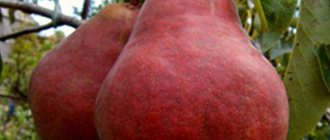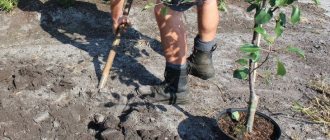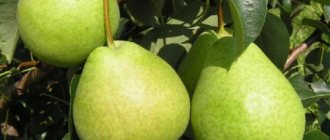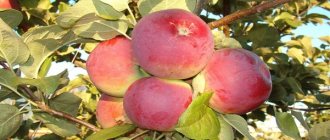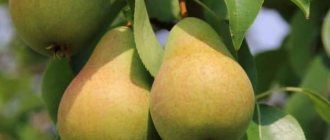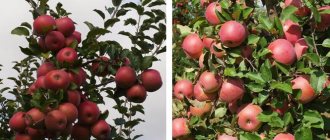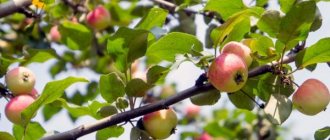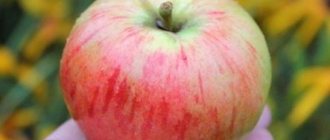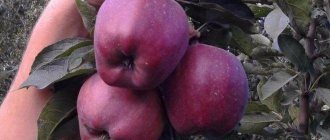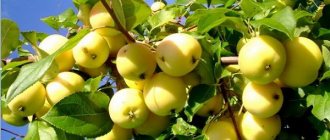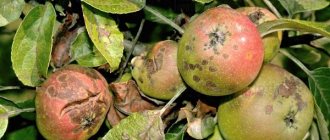Creation of a variety
The pear variety “Yakovlev’s favorite” was created at the All-Russian Research Institute of Genetics and Selection of Fruit Plants. It was obtained by crossing the varieties “Blankova’s daughter” and “Esperen’s bergamot”. The creators are I. Michurin and P. Yakovlev.
The pear “Yakovlev’s favorite” has become popular in the middle zone.
At first, this variety was grown in large areas, but now it grows only in private gardens. Pears of this variety take root best and bear fruit in the middle zone: in the Penza, Belgorod, Tambov, and Moscow regions.
Pear variety Lyubimitsa Klappa - description of appearance and other characteristic features
Clapp's Favorite is a very venerable pear variety that will soon celebrate its 150th anniversary. It is sometimes found in catalogs under the name Clapp's Favorite or Favorite. The hybrid was bred by a breeder from the USA T. Clapp, and was named in honor of the author. Its “parents” are the Forest Beauty and Williams varieties. Both have remarkable taste and belong to the group of the first successful experiments in the field of pear breeding.
There is a version according to which Clapp’s Favorite is the result of a spontaneous mutation of one of the mentioned varieties.
Klappa's Favorite pear - a variety with a long history
In Russia (then the USSR), they became acquainted with the variety in the middle of the 20th century. Klapp's favorite is perfect for cultivation in the North Caucasus region and the Kaliningrad region. Gardeners from the Baltic states, Moldova, Ukraine and Belarus immediately fell in love with it. Over time, the variety acquired greater winter hardiness and was successfully zoned for cultivation in the Lower and Middle Volga regions.
Clapp's favorite is a vigorous tree with a spreading crown that rounds out with age, taking the shape of a ball instead of the initial pyramid. Young seedlings demonstrate especially high growth rates. Shoots that formed 2–3 seasons ago droop slightly, then become lignified and “straighten up.”
Clapp's favorite is a fairly tall tree with a spreading crown, so it is not easy to care for.
The variety is self-sterile; without pollinators, fruits are not set. It is advisable to have at least 3 different trees. Suitable “companions”:
- Williams;
- Ilyinka;
- Forest Beauty;
- Panna;
- Saint Germain;
- Dekanka Winter;
- Bere Bosc;
- Ligel;
- Olivier de Serres;
- Bere Giffard.
Clapp’s favorite cannot boast of precociousness. The first pears are removed 7–8 years after planting the tree. But the “productive” life span is 50–55 years. With proper care it can be extended for another 10–15 years. Productivity is high - in particularly successful years, about 300 kg of fruits are harvested from one tree.
The harvest of Clapp's Favorite almost always pleases the gardener
The ripening period depends on the climatic conditions of the area in which the pear grows and the weather in spring and summer. In favorable conditions in the southern regions, the fruits are harvested at the end of July or the first ten days of August. Where the weather is more severe (Moscow region, etc.) - on the 20th of August.
The fruits are classically pear-shaped, slightly flattened along the vertical axis, weighing on average 180–240 g.
On young trees, pears weighing up to 280 g ripen; with age, the fruits become smaller to 110–140 g, but this does not affect the taste in any way.
The skin is glossy, sunny yellow; where it is illuminated by the sun, a bright carmine “blush” is formed. Slight tuberosity, slight rustiness at the base of the fruit and small subcutaneous dots are normal. Unripe pears have a greenish tint.
The taste of ripe pears receives only praise (even from the most fastidious connoisseurs). The snow-white pulp is very tender and juicy, sweet, without pronounced graininess, with a slight wine flavor and barely noticeable sourness. Professional tasters rate the taste 4.7–4.8 points out of 5, and children simply love these pears and will never give them up.
The snow-white pulp of Klapp's Favorite has excellent taste.
The variety has a universal purpose. In addition to fresh consumption, Klappa's Favorite is suitable for home canning, baking, drying, and drying. Fresh fruits will last for a maximum of 10–15 days. If you remove them slightly unripe, the shelf life can be extended by 5–7 days, but no more. Such pears tolerate transportation well.
Breeders continue to experiment with Clapp's Favorite. At the moment, more than 20 varieties bred with her participation are registered. The most successful hybrids are Skromnitsa, Naryadnaya Efimovka, Tatyana, Orlovskaya Letnyaya, Severyanka and Usolka.
Clapp's favorite not only produces a harvest of wonderfully tasty pears, but also blooms beautifully
Description of the variety
The “Yakovlev’s favorite” pear ripens in the fall. The variety is valued for its productivity, frost resistance and decorativeness.
The tree is tall, its crown is wide-pyramidal. Skeletal branches are located almost perpendicular to the trunk. It grows very quickly. Some gardeners consider this a disadvantage because the tree's crown is too wide.
The bark of large branches is gray and quite smooth. Shoots with a large number of spears and ringlets on which fruits are formed.
The leaves are of a regular shape, pointed, their tips curled to the side. The flowers are simple. There are up to 10 of them in inflorescences. The pear “Yakovlev’s favorite” begins to bloom later than all varieties. This saves the crop from return frosts.
Autumn
The advantages of autumn varieties are captivating - they have the high taste of summer varieties and the long shelf life of winter ones.
Veles
One of the best representatives of autumn varieties. The size of the tree is medium, the branches are drooping, rounded pyramidal. Unpretentious Veles only needs regular pruning.
Pros:
- taste qualities of the crop;
- compact size of the tree;
- high immunity;
- unpretentiousness.
Minus:
- Without pruning, the tree quickly thickens.
Red-sided
The pear is medium in size and height, round and compact. The variety is completely unpretentious and feels good even in partial shade. But in order for the fruits to be fully plumped and acquire their taste, the tree needs watering.
Pros:
- long shelf life;
- appearance and taste of fruits;
- unpretentiousness.
Minus:
- need for additional watering.
Marble
The tree is large and even huge, the crown is dense. A large number of small branches grow very quickly and intertwine with each other.
Pros:
- high productivity;
- frost resistance;
- long shelf life;
- not afraid of pests.
Minus:
- You have to wait 5 years for the first harvest.
Pear Marble.
Description of fruits
The fruits are wide pear-shaped, large, one-dimensional, weighing from 120 to 180, sometimes 200 g.
They are green-yellow in color, but from a distance they appear brown. The dense, smooth, but dull skin of the fruits, ripening on the sunny side, is decorated with a faint blush. A large number of cover points are located close to each other.
The saucer (lower part) is ribbed, the funnel is shallow.
The pulp is juicy, cream-colored, not very dense. Pears are sweet and sour, pleasant in taste, reminiscent of quince. Under unfavorable conditions they become a little tart.
There is a certain amount of solid formations inside the pulp. This slightly reduces the quality of the fruit. But still, the pear “Yakovlev’s favorite” is highly valued by gardeners.
The description of the variety speaks of its winter hardiness. The branches of mature trees do not freeze even in severe frosts. But young seedlings need to be protected in winter. And not only branches, but also plant roots. For this, it is good to use green manure straw. It protects the trees from frost and supplies them with minerals.
In autumn, the trunk is wrapped in thick paper and covered, without tamping, with a layer of earth up to 20 cm high. After the snow falls, throw as much of it as possible onto the tree trunk circle. In this way, the tree is protected not only from frost, but also from mice, which can damage the plant bark in winter.
Botanical characteristics
Yakovlev’s favorite has a high growth rate. The tree is large, with a broad pyramidal crown. It can reach a height of 3 to 8 m. A notable feature is the horizontal arrangement of the skeletal branches, which greatly simplifies caring for the plant and harvesting the crop. The bark of the trunk and lignified branches has a uniform gray tint, without folds or pronounced roughness. The shoots are not too thick, with weakly defined knees. The density of the leaf mass covering is average. The buds are small in size, have an elongated shape, are pointed at the ends, and are pressed tightly against the shoots.
The leaf blades are elongated, curved, and have a noticeable fold along the central vein. The leaf surface is shiny, bright green. Stipules are lanceolate. The petioles are of medium length and dense. Flowers are of a simple type, less often semi-double. Painted white. Collected in inflorescences of 7–10 pieces. Flowering is later, observed in May.
The fruits ripen by early September. The yield of the harvest is spread over a month. The variety is relatively fast-growing. The first harvest is produced already in the 5th–6th year from the moment of planting. Productivity increases with age. For seven-year-old plants it is from 20 kg per tree. Already from 13–14 years old it can range from 40 to 100 kg per tree. The average yield from 1 hectare of mature plants is 220 centners.
Did you know? It takes the human body 40 minutes to digest a pear.
The variety is partially self-fertile. This means that without a pollinator, only 15% of the fruits on the tree will set. The variety is characterized by high frost resistance. The plant can withstand frosts down to -30°C. The weight of the fruit varies between 130–190 g. Its shape is broadly pear-shaped. The surface of the fruit is smooth, one-dimensional. The peel is medium dense. The color is light green with a yellow tint and a faint red blush. Numerous subcutaneous points are clearly visible.
The most suitable pollinator for Yakovlev's Favorite is Duchess summer. The lower part of the fruit has ribbing. The funnel is small. The flesh is cream colored. It has a medium-dense structure and pronounced granularity. Juicy, pleasant to taste. The pulp is quite sweet with noticeable sourness. Regarding use, the fruits are universal. Excellent for eating fresh, for winter preparations and preparing various dessert dishes. They tolerate transportation well and are resistant to mechanical damage. In dry years, a large number of stony cells form in the pulp, which greatly spoils the taste.
Did you know? The pear was cultivated as early as 100 BC. e. Moreover, the plant spread to the Western Hemisphere of our planet only 400 years ago.
Preparing the landing site
Young pear seedlings are planted in the ground in spring or autumn. Survival rate is better in autumn. You just need to not be late with the boarding deadlines. It is better to do this at the end of September.
Two weeks before the pear is planted, a place is prepared for it. The soil for the seedling should be clay or loamy.
The “Yakovlev’s favorite” pear is tall, so it needs to be planted so that in the future it does not cover the entire garden area. At the same time, the area should be spacious and bright. It grows well on hills and slopes, but poorly in lowlands.
You can form a small mound yourself and plant a pear in it.
There is no need to plant a pear near a rowan tree. She herself will not interfere, but their pests are the same. Moreover, first they attack the rowan tree, and then move to the pear tree.
A hole for the seedling is dug measuring 100x70x70. The fertile soil of the top layer is piled separately from the bottom. Add rotted manure or compost, superphosphate, and potassium salt.
Belarusian late
Late Belarusian pear has not lost its popularity for several decades. The main reason is that this is one of the latest varieties of pear, which is very important for those who want to enjoy pears not only during the summer, but also in the winter. However, this is not the only advantage of the variety.
Belorussian Late is a fairly productive variety: up to 180 kg of pears are harvested from an adult tree. The taste of the fruit is also highly valued. Their flesh is juicy, oily, sweet, and aromatic. The color of the fruit depends on the degree of ripening and varies from greenish with red spots to yellow with a crimson blush.
It is recommended to harvest crops intended for long-term storage 2-3 weeks before full ripening.
Among the disadvantages of the variety is the lack of resistance to diseases and pests.
| Entry into fruiting | Tree height (m) | Fruit weight (g) | Harvest | Shelf life (days) |
| For 3-4 years | 3-5 | 110 | Second half of September | 150-180 |
Planting
A stake at least 1.5 m high is driven into the prepared hole, which will serve as a support for the young tree for several years. You can do this after planting, but then there is a risk of damaging the root system.
Before planting, the roots are lightly trimmed down to living tissue (this applies more to spring planting) and dipped in clay mash.
A layer of fertile soil mixed with fertilizers is poured into the bottom of the hole. Place the seedling in the hole. In order to do this correctly, first determine where the root collar is located. The seedling is immersed in a hole so that after planting it rises 5 cm above the ground.
Sprinkle the pear with earth so that there are no voids left in the hole. To do this, lightly compact the soil with your foot, controlling the effort so that the roots do not break off.
They tie the tree to a stake. They use a non-rigid material that is wrapped around the trunk in the shape of a figure eight.
Be sure to mulch with humus, peat, straw or fresh grass, which quickly dries out and becomes hay. This will help retain moisture inside the root system. You just need to make sure that during heavy and prolonged rains the tree trunk circle is not too damp. In this case, the mulch is moved away for a while until the rains stop and the soil dries out.
You need to monitor the condition and availability of mulch throughout the season. Replenish the layer if it becomes less than 7 cm.
Care
Caring for the “Yakovlev’s favorite” pear is not difficult. It is necessary to water it regularly during growth, preferably by sprinkling. Watering is done in the morning or evening. You can water trees in a ditch made in a circle around the trunk.
Trees up to 7 years old need 30 liters of water, adults – more.
Be sure to water the pear before flowering and in the fall, before wintering. This will help to form more fruit buds and better withstand frost.
After the water is absorbed into the soil, loosen the ground around the tree.
Feeding
The pear variety “Yakovlev’s Favorite” responds well to fertilizing. Reviews from experts recommend using:
- humus, infusion of manure or chicken droppings;
- mineral fertilizers (after 3-4 years).
Nitrogen fertilizers are applied in the first years of life if the tree grows very slowly.
They fertilize by making shallow holes in the tree trunk circle half a meter from the trunk. Before and after the procedure, the pear is thoroughly watered so that fertilizers do not damage the roots. Then the holes are filled in and the area around the tree trunk is mulched.
According to reviews from gardeners, it is better not to fertilize a mature tree too much. In order for the fruits to become larger, anti-aging pruning is carried out.
Foliar feeding gives good results. This is spraying with a sulfate solution during flowering, or with urea after the bulk of the leaves have turned yellow. Such fertilizing strengthens the tree and helps it survive the winter easier.
Krasulya
Krasulya is one of the fastest ripening varieties: the first pears ripen already in early August. The fruits are round in shape and have a bright red color when fully ripe. The pulp is juicy, loose, slightly oily, and very sweet due to the large amount of sugars.
The variety is winter-hardy, but in the first years of life, before fruiting begins, it is recommended to insulate the trees for the winter. Krasulya is resistant to many diseases; it is practically not affected by scab and bacterial burn.
Among the disadvantages of the variety are the presence of thorns on the fruit branches and the short shelf life of the fruit. Krasulya pears are used mainly for processing and only immediately after harvesting are they consumed fresh.
| Entry into fruiting | Tree height (m) | Fruit weight (g) | Harvest | Shelf life (days) |
| For the 4th-5th year | 4 | 90 | Early August | 7-14 |
Crown formation
- The branches are removed by cutting them into rings.
- The crown shape is sparsely tiered or palmette.
- Two-year-old pear branches are shortened by a quarter.
- In spring and autumn, pruning of broken branches is carried out.
Every 3 years, three-year-old branches are cut off, on which fruits no longer form.
Formative and sanitary pruning is carried out in spring and autumn. Remove branches growing towards the crown, one of two parallel, vertical, if any.
Pruning is done with sharp pruning shears so as not to damage the tree bark. Hold it at right angles to the branch.
The cut areas are treated with garden pitch or other putty.
Features of cultivation and subtleties of care
Pears need the usual agrotechnical procedures: watering, fertilizing, pruning. Let us note some features of these stages.
Watering
Drought resistance, as indicated in the description of the variety, is not a strong point of the Pamyatya Yakovlev pear and the two other varieties under consideration. Therefore, they will have to be watered regularly, every 20-30 days. The first watering of the season is usually done before the pear blossoms, and the last in October. When watering, you should follow some rules:
- The depth of soil moisture should be 25-35 centimeters.
- Before watering, the tree trunk is covered with earth to prevent direct contact with water. This avoids overheating of the root collar.
- After watering, the soil should be loosened to ensure oxygen supply to the roots.
- Mulching the soil around the tree trunk allows you to retain moisture longer and increase the interval between waterings.
- You should periodically check the condition of the mulch layer - slugs and beetles can accumulate in it. In this case, the mulch is removed, pests are destroyed, and the soil is dried. Mulching can be resumed at the next watering.
Feeding
3-4 years after planting, the nutrient mixture in the planting hole will begin to deplete. And also by this time, the Yakovlev Memory pear begins to bear fruit, which requires additional nutrition. From now on, fertilizing will be needed annually.
- Organic fertilizers (compost, humus, peat) are applied in the spring during digging at intervals of 2-3 years. As a rule, 5-7 kilograms of fertilizer are used per square meter of tree trunk circle.
- At the same time, but already annually, mineral nitrogen-containing fertilizers (ammonium nitrate, urea, nitroammophosphate, etc.) are applied. Their consumption is 20-30 g/m2.
- During the rapid growth of young shoots and fruits, mineral potassium fertilizers (potassium sulfate, potassium monophosphate) are applied. They are dissolved in water and used when watering the tree. Fertilizer consumption is 10-20 g/m2.
- Superphosphate is added for digging in the fall at the rate of 20-30 g/m2.
- In addition, in order to support the plant during fruit growth, it is fed two to three times with liquid organic infusions. To do this, place two liters of mullein or one liter of bird droppings in a barrel and fill it with a bucket of water. Leave in a warm place for 5-7 days for fermentation, after which it is filtered and used for feeding. A bucket of water with one liter of concentrate dissolved in it is poured onto one square meter of the tree trunk circle. Instead of mullein, you can also use nettles, weeds, or any grass in the amount of 5-7 kilograms per bucket of water.
- In addition to basic fertilizers, pears require microelements, so do not forget about complex mineral fertilizers. They are used according to the attached instructions.
How to prune a pear correctly
There are four main types of pruning - formative, regulating, maintaining and sanitary. The rules for their implementation depend on the height of the tree, the shape and density of the crown. The varieties Osennyaya Yakovleva and Lyubimitsa Yakovleva are similar - both have a tall tree with a sparse crown. Therefore, the descriptions of prunings for these varieties can be combined.
Formation of the crown of a pear in memory of Yakovlev
Since the tree of this variety is small, we use a molding for it in the form of an improved bowl. This shape contributes to good illumination of the internal volume of the crown and its ventilation. Makes tree care and harvesting easier. Step-by-step instructions for formative pruning look like this:
- In early spring, one to two years after planting, the tree is inspected and three to four strong branches are selected, located at a distance of 15-20 centimeters from each other. At the same time, they should grow in different directions. These are future skeletal branches.
- They are cut to a length of 30-40 centimeters.
- All other branches are cut out completely.
- The central conductor is cut above the base of the upper branch.
- After 1-2 years, they begin to form second-order branches. To do this, select two shoots on each skeletal branch, located at a distance of 50-60 centimeters from each other, and cut them to a length of 40-50 centimeters.
- All other branches on the skeletal ones are removed.
- In the future, the crown of the tree will become very thick, which will require annual regulatory pruning, which is carried out in early spring by removing part of the shoots growing inside the crown. They do this within reasonable limits, since excessive pruning entails a slight reduction in yield.
The formation of the crown according to the type of improved bowl contributes to good illumination of the internal volume of the crown and its ventilation
Formation of pear crowns Autumn Yakovleva and Lyubimitsa Yakovleva
For these pears, due to their tallness, it is more logical to use a sparsely tiered crown formation. Its implementation is somewhat more complicated than the bowl-shaped one, but it is quite accessible to a novice gardener. To do this, you should carefully study the step-by-step instructions:
- In early spring, 2-3 years after planting, you need to select 2-3 future skeletal branches of the first tier on the tree. For this, branches located at intervals of 15-20 centimeters are suitable, and the bottom one should be at a height of about forty centimeters from the ground. These branches are cut to a length of 30-40 centimeters.
- The remaining branches are removed, and the central conductor is cut so that it is 20-30 centimeters higher than the skeletal branches.
- After 1-2 years, above the branches of the first tier, the second tier of skeletal branches is formed using the same principle.
- By this time, other branches had probably already grown on the branches of the first tier. Of these, branches of the second order are formed, 1–2 pieces on each skeletal branch, the rest are cut out. The distance between branches of the second order should be within 50–60 centimeters and they are cut to a length of 30–40 centimeters.
- The central conductor is again shortened so that it is 30-40 centimeters higher than the skeletal branches.
- After the next one or two years, the third and last tier of skeletal branches is formed according to the already familiar algorithm.
- Finally, the central conductor is cut out above the base of the superior skeletal branch.
- Since the varieties in question are not prone to thickening the crown, they are unlikely to need regulatory pruning.
When forming a sparsely-tiered crown, the principle of subordination should be observed. It lies in the fact that the branches of the third tier should be shorter than the branches of the second tier, and they, in turn, are shorter than the branches of the first tier.
For pear varieties Osennyaya Yakovleva and Lyubimitsa Yakovleva, a sparse-tiered crown formation is used
Maintenance pruning
This pruning is necessary regardless of the pear variety and is aimed at maintaining a constant and high level of fruiting. This is achieved by the so-called minting of young shoots, which consists of shortening them by 5-10 centimeters. This encourages the appearance of additional overgrowing branches on which fruit buds are laid. This method is easily accessible to a novice gardener. Subsequently, he will be able to master a more complex method, which consists in replacing fruit-bearing shoots with replacement shoots similar to the type of grape formation.
Experienced gardeners use the method of replacing fruiting shoots with replacement shoots
Sanitary pruning
Every autumn, regardless of the pear variety, dry, damaged and disease-affected branches are removed. If such a need arises, then sanitary pruning is repeated in early spring.
How to prune pear trees correctly
All of the above types of pruning must be carried out in compliance with the general requirements:
- Hacksaws, pruners, loppers, knives must be sharpened before cutting.
- And also the cutting tool should be treated with a disinfectant composition, for example: 1% solution of copper sulfate;
- 3% hydrogen peroxide solution;
- 3% solution of potassium permanganate;
- alcohol, etc.
When cutting out entire branches, use the “ring” technique
Experienced gardeners recommend avoiding the use of garden varnishes based on petrolatum or other petroleum products, as this is harmful to the plant. There are compositions based on natural ingredients (lanolin, beeswax) - these should be preferred.
Diseases and pests
Resistance to scab in this pear variety is low. Therefore, it needs to be constantly processed. There are now a large number of effective drugs to combat scab.
Pests:
- leaf rollers;
- weevils;
- codling moths;
- scale insects;
- aphid.
To reduce the number of pests in the garden:
- attract birds there;
- in the fall, remove fallen leaves;
- clean the trunks of old bark, treat them with pest control agents (“Aktara”, “Grom”) and lime;
- loosen the soil near the tree.
What types of pears are there?
It is difficult to choose the right variety among the large number presented. To understand, you need to understand what varieties are presented.
According to the ripening time of pears, there are
:
- summer;
- autumn;
- late;
- winter.
According to adaptability to different conditions
:
- immune;
- winter-hardy.
By tree size:
- tall;
- short;
- average;
- dwarf;
- columns.
Harvesting
At the beginning of September, the “Yakovlev’s favorite” pear begins to ripen. The description of the variety and reviews from gardeners indicate that the fruits do not reach the ripening stage together. The fruiting period is extended over time, which consumers like. After all, they can enjoy fresh pears longer.
The first fruits should be harvested in mid-September. And they are consumed in October and early November.
Winter
The difference between winter varieties is the long shelf life of fruits and the ability to transport them. But they are often removed from the tree when they are not yet fully ripe.
Pass-Krasan
A variety of winter pears with some growing requirements, but with very remarkable fruits. Medium-sized hybrid, very productive and prolific.
Pros:
- taste of fruits;
- amount of harvest;
- precociousness.
Minuses:
- whimsicality;
- susceptibility to disease;
- weak immunity.
Pervomayskaya
The tree of this variety is distinguished by its tall growth and size. The pear is tall, more than 10 meters tall, with a wide crown. She is not sick at all and is not afraid of pests. The tree is very frost-resistant, so the variety is grown almost everywhere.
Pros:
- pleasant taste;
- long shelf life;
- frost resistance;
- a large amount of harvest.
Minuses:
- large tree.
Lyra
The Lyra pear is tall, large and bushy. The yield is annual and plentiful, the resistance to cold is average. An undoubted advantage in resistance to diseases and pests.
Pros:
- good immunity;
- long shelf life;
- taste qualities of fruits.
Minus:
- exposure to frost;
- large size tree.
